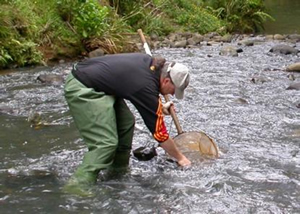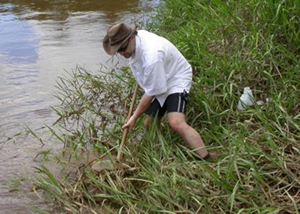Sampling tips
In this section
Collecting samples: shallow stony streams
A good sampling method for shallow stony streams involves placing a net (we use a mesh size of 0.5 mm, but a large kitchen sieve with 1-mm mesh works too!) in the stream and disturbing the streambed immediately upstream. Fine material including invertebrates will drift into the net (or sieve).
Collecting samples: weedy and stagnant habitat
In weedy and stagnant habitats, you may need to sweep a net through submerged vegetation to collect sample material. You don’t need to collect bucketloads of material – we usually collect about 400 ml of material. Whatever method you use, make sure you do it safely!
Processing samples
Once you’ve collected your sample, it’s a good idea to place the net contents into a shallow white tray with enough water to allow invertebrates to swim or crawl (they may be hard to see until they start moving). You may need to spread your sample over several trays to see a wide range of invertebrates. You can do this in the field, or take the sample material back to the lab or classroom for a closer look. Of course magnifying glasses or microscopes will allow you to see the invertebrates in a great deal more detail.


